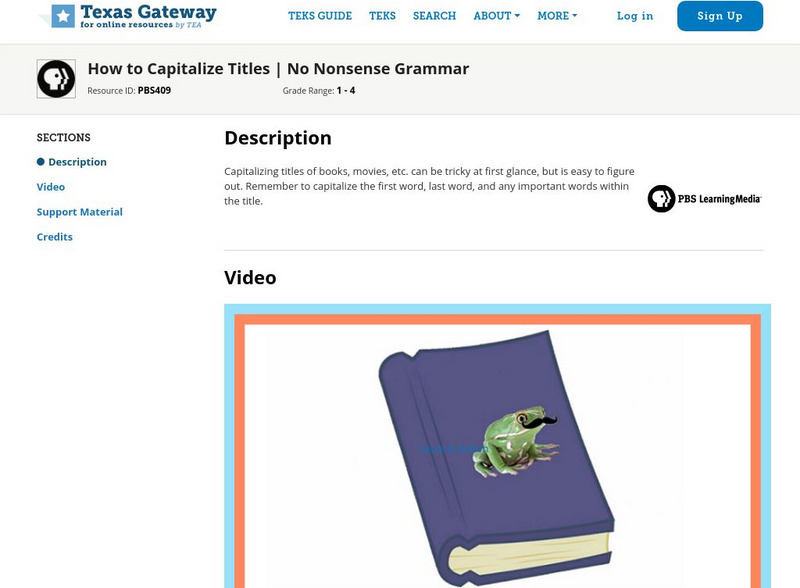Teachnology
Teachnology: Lesson Plan: Thank You Mr. Restaurant
For this lesson students learn about the parts of a business letter and write letters to their favorite restaurants thanking them for their service. The letters are edited and then mailed.
TES Global
Tes: When Do We Use Capital Letters? Poster?
[Free Registration/Login Required] Capitalization rules are provided on this visually-appealing poster. Students will find reminders about capitalizing the pronoun I, beginnings of sentences, names, abbreviations, and abbreviations.
Khan Academy
Khan Academy: Meet the Apostrophe
Self-checking quiz tests understanding of apostrophes. Immediate feedback is given and hints or a video are available if needed.
Khan Academy
Khan Academy: Punctuation: Comma and Apostrophe: Introduction to the Possessive
Five self-correcting quiz questions over possessive pronouns.
Grammarly
Grammarly Blog: Comma
This page focuses on comma use; it explains the importance of the comma and provides an example of how drastically a comma can change the meaning of a sentence. It also provides links to 38 different pages of comma rules and examples.
ClassFlow
Class Flow: Chunk Lesson Ide
[Free Registration/Login Required] Use literature and the Whole-Part-Whole Method to teach individual word chunks. This flipchart focuses on the -ide word chunk.
English Worksheets Land
English Worksheets Land: Using Commas in Dates and With Single Words
Eight printable worksheets about using commas in a series, and seven printable worksheets about using commas in dates are available with answer keys.
Other
Tls Books: Letter From San Diego [Pdf]
A printable activity for students to practice their skill in using commas and capital letters.
Other
Letters and Parts of a Letter Worksheets
This resource provides four worksheets that students can use to review the parts of a friendly letter. Each worksheet addresses the need for commas in designated parts of a letter.
abcteach
Abcteach: Writing
[Free Registration/Login Required] These worksheets give beginning writers the opportunity to practice their skills. In downloadable and printable PDF format (requires Adobe Reader).
Goodwill
Gcf Global: Capitalization
In this lesson, students learn when to use capitalization in their writing.
Texas Education Agency
Texas Gateway: How to Capitalize Titles | No Nonsense Grammar
Capitalizing titles of books, movies, etc. can be tricky at first glance, but is easy to figure out. Remember to capitalize the first word, last word, and any important words within the title.
PBS
Pbs: No Nonsense Grammar: Using Proper Punctuation for Titles
This video focuses on correctly punctuating titles. Small works (short stories, essays, magazine and newspaper articles, etc.) are indicated with the use of quotation marks. Larger works, such as books or movies, are indicated either...
BBC
Bbc: Skillswise: Plurals and Spelling Rules
The rules for spelling plural words and using them properly in English are made fun and easy with this BBC Skillswise worksheet for students.
Better Lesson
Better Lesson: Email Clarifying Questions
At the end of this lesson, students will demonstrate the use of commas, clarifying questions, and a friendly letter format by sending an email. Email is part of student's lives, and it is part of the digital landscape they will need to...
Alabama Learning Exchange
Alex: Pass the Punctuation, Please!
During this lesson students will listen to the story, Noisy Nora by Rosemary Wells and identify punctuation used in the story. Students will also play games to strengthen knowledge of punctuation usage. They will then use the Internet to...
Alabama Learning Exchange
Alex: Writing Thank You Notes
This activity teaches young scholars to write thank-you note using the writing process. Students will draft, revise, edit, and publish their thank-you notes. They will use a computer to view examples of thank-you notes and insert...
PBS
Pbs Learning Media: How to Use the Correct Capitalization
Capitalizing is extremely important. Not only is it proper writing, but it also makes writing look polished and finished. Learn what should be capitalized and what shouldn't! [0:53]
PBS
Pbs Learning Media: Using Commas and Quotations
Quotations and commas are two very useful punctuation tools that indicate dialogue and brief pausing in sentences. Learn how to use them correctly! [0:46]
PBS
Pbs Learning Media: How to Introduce Lists and Quotes With Colons
Colons are punctuation marks that can signal a quotation. However, to use colons correctly, whatever comes before the colon must be a complete sentence. Know when and how to use colons! [0:45]
PBS
Pbs Learning Media: Using Punctuation for Breaks and Pauses
Punctuation indicates how one should read any sentence. Commas, for example, indicate when a reader should take a brief pause, either for emphasis or for comprehension. [0:40]
PBS
Pbs Learning Media: How to Use Commas for Introductory Elements
Introductory elements are clauses, phrases, and words that appear before the main part of a sentence. Without commas, the reader may be confused. Use commas to indicate properly the who and the what. [0:40]
PBS
Pbs Learning Media: How to Punctuate Items in a Series
Another way to confuse readers or audiences is not using commas and conjunctions when listing items in a series. Always use a comma in between items in a series, and use a conjunction before adding the last item in a list. [0:44]
PBS
Pbs Learning Media: How to Use Commas With Conjunctions
Conjunctions can join two separate clauses, but sometimes they need commas. Learn how to do so correctly with this video. [0:48]









![Tls Books: Letter From San Diego [Pdf] Unknown Type Tls Books: Letter From San Diego [Pdf] Unknown Type](https://d15y2dacu3jp90.cloudfront.net/images/attachment_defaults/resource/large/FPO-knovation.png)





